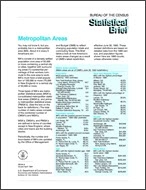Statistical Brief: Metropolitan Areas
Statistical Brief: Metropolitan Areas
You may not know it, but you probably live in a metropolitan area (MA). About 4 in every 5 Americans do!
MA’s consist of a densely settled population core area of 50,000 or more containing a central city or cities, together with surrounding areas if a substantial percentage of their workers commute to the core area to work. MA’s must have a total population of 100,000 or more (75,000 in New England) or a central city of 50,000 or more.
Three types of MA’s are metropolitan statistical areas (MSA’s), consolidated metropolitan statistical areas (CMSA’s), and primary metropolitan statistical areas (PMSA’s). (See the box on the back for definitions.) The total number of metro areas consists of the combined number of CMSA’s and MSA’s.
MSA’s, CMSA’s, and PMSA’s are defined in terms of counties except in New England, where cities and towns are the building blocks.
Periodically, the number and boundaries of MA’s are updated by the Office of Management and Budget (OMB) to reflect changing population totals and commuting flows. This Brief takes a look at how America’s metro areas changed as a result of OMB’s latest redefinition, effective June 30, 1993. These revised definitions are based on detailed data from the 1990 census, and population figures shown here are 1990 counts, unless otherwise noted.
Others in Series
Publication
Publication
Publication




